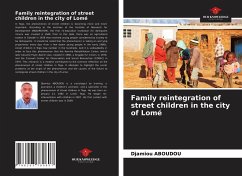In Togo, the phenomenon of street children is becoming more and more important. According to the archives of the Institute of Research for Development (IRD/ORSTOM), the first re-education institution for delinquent minors was created in 1949. Prior to this date, there was an agricultural station in Sokodé in 1928 that received young people considered by society to be delinquents. It should be noted that the phenomenon is taking on worrying proportions every day: from a few dozen young people in the early 1960s, street children in Togo now number in the hundreds. And it is undoubtedly in order to face this phenomenon that the Kamina Rehabilitation Center (which later became Foyer Avenir) was created in 1960, a brigade for minors in 1970, and the Cacaveli Center for Observation and Social Reinsertion (CORSC) in 1970. This research is a modest contribution to the common reflection on the phenomenon of street children in Togo. It attempts to highlight the social problems at the origin of the phenomenon and the causes of the failure to reintegrate street children in the city of Lomé.
In Togo, the phenomenon of street children is becoming more and more important. According to the archives of the Institute of Research for Development (IRD/ORSTOM), the first re-education institution for delinquent minors was created in 1949. Prior to this date, there was an agricultural station in Sokodé in 1928 that received young people considered by society to be delinquents. It should be noted that the phenomenon is taking on worrying proportions every day: from a few dozen young people in the early 1960s, street children in Togo now number in the hundreds. And it is undoubtedly in order to face this phenomenon that the Kamina Rehabilitation Center (which later became Foyer Avenir) was created in 1960, a brigade for minors in 1970, and the Cacaveli Center for Observation and Social Reinsertion (CORSC) in 1970. This research is a modest contribution to the common reflectionon the phenomenon of street children in Togo. It attempts to highlight the social problems at the origin of the phenomenon and the causes of the failure to reintegrate street children in the city of Lomé.
In Togo, the phenomenon of street children is becoming more and more important. According to the archives of the Institute of Research for Development (IRD/ORSTOM), the first re-education institution for delinquent minors was created in 1949. Prior to this date, there was an agricultural station in Sokodé in 1928 that received young people considered by society to be delinquents. It should be noted that the phenomenon is taking on worrying proportions every day: from a few dozen young people in the early 1960s, street children in Togo now number in the hundreds. And it is undoubtedly in order to face this phenomenon that the Kamina Rehabilitation Center (which later became Foyer Avenir) was created in 1960, a brigade for minors in 1970, and the Cacaveli Center for Observation and Social Reinsertion (CORSC) in 1970. This research is a modest contribution to the common reflectionon the phenomenon of street children in Togo. It attempts to highlight the social problems at the origin of the phenomenon and the causes of the failure to reintegrate street children in the city of Lomé.








